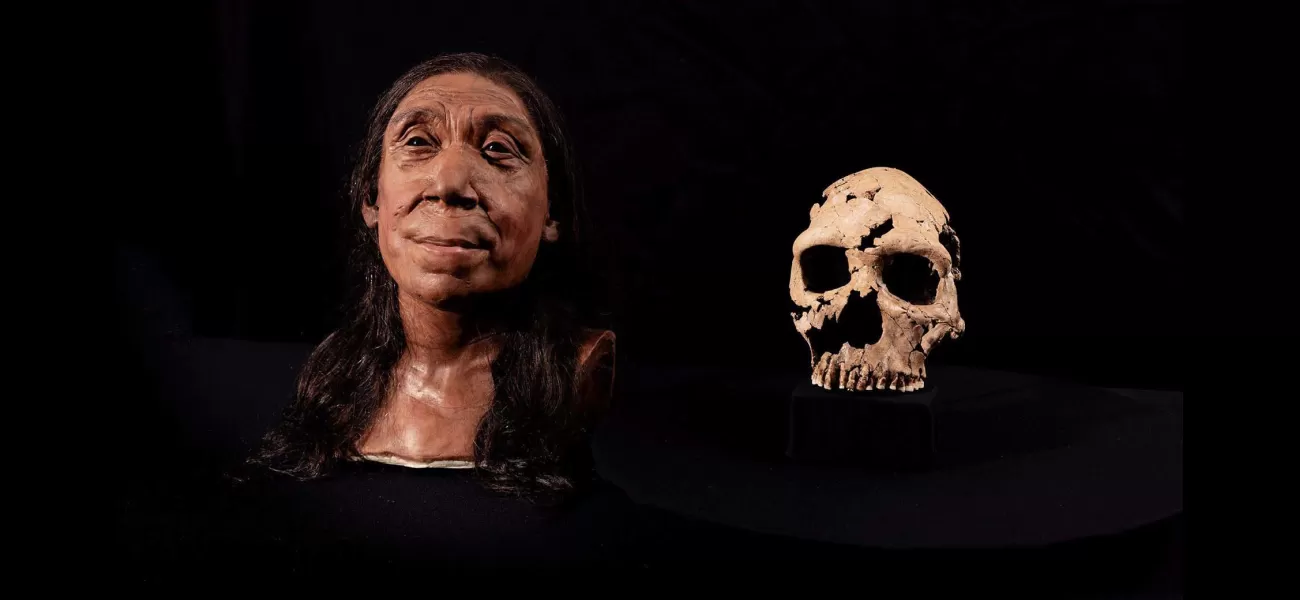Researchers uncover appearance of Neanderthal from 75,000 years ago.
A woman in her 40s was buried in a cave 75,000 years ago, in a specially carved out space.
May 2nd 2024.

A woman in her 40s, who lived over 75,000 years ago, was found buried in a cave in Iraqi Kurdistan in 2018. The cave was carefully hollowed out to accommodate her body, with her left hand placed under her head and a rock behind her head possibly used as a cushion. This woman, known as Shanidar Z, was a Neanderthal, an ancient human species that disappeared about 40,000 years ago.
Scientists studying her remains have spent nine months piecing together her skull from over 200 bone fragments. Using the contours of her face and skull, they have created a striking reconstruction to get an idea of what she may have looked like. This reconstruction is featured in a new documentary called "Secrets of the Neanderthals" produced by BBC for Netflix, which will be available for streaming on Thursday.
According to Dr Emma Pomeroy, a paleoanthropologist and associate professor at the University of Cambridge, who unearthed the skeleton and appears in the documentary, Neanderthal skulls have distinct features such as pronounced brow ridges and lack of a chin. However, the facial reconstruction of Shanidar Z suggests that these differences might not have been as stark in her lifetime. Pomeroy explains that while there is some artistic interpretation involved, the reconstruction is based on real data and the real skull of the Neanderthal, giving us a glimpse into their appearance.
It is estimated that Neanderthals lived for about 300,000 years in Europe, the Middle East, and the Central Asia Mountains, overlapping with modern humans for about 30,000 years. Recent analysis of DNA from present-day humans has shown that Neanderthals and Homo sapiens occasionally interbred during this time.
When Pomeroy first found the skeleton, it was not immediately clear whether it was a male or female as only the upper half of the body was preserved. But a relatively new technique involving the sequencing of proteins inside tooth enamel was used to determine Shanidar Z's sex, which is revealed for the first time in the documentary. The researchers also estimated her height to be around 1.5 meters by comparing her arm bones with data on modern humans. It is believed that she was in her mid-40s at the time of her death, making her someone who had lived a relatively long life and would have been highly respected in her society.
The cave where Shanidar Z was buried is well-known among archaeologists as it was the site where a Neanderthal grave was discovered in 1960, leading to the belief that these humans may have buried their dead with flowers. However, subsequent research has cast doubt on this theory, with Pomeroy's team suggesting that the pollen found among the graves may have been brought in by pollinating bees. Over the years, evidence of Neanderthals' intelligence, sophistication, and complexity has been found, including art, string, and tools.
The Shanidar Cave has yielded the remains of 10 Neanderthals, half of whom were buried deliberately in succession. While it is not certain whether Neanderthals buried their dead with flowers, researchers believe that they were an empathetic species. For example, one male Neanderthal buried at the site had disabilities which would have required care from others, suggesting that they had a sense of compassion.
Pomeroy states that Shanidar Z is the first Neanderthal found at the site in over 50 years, but there could be more discoveries waiting to be made. During the filming of the documentary in 2022, Pomeroy and her team uncovered more Neanderthal remains, including a left shoulder blade, rib bones, and a right hand, possibly belonging to another individual.
Reconstructing Shanidar Z's skull was a challenging task, as it had been crushed soon after death. The fossilized bones were hardened with a glue-like substance and carefully removed from the cave sediment in small blocks. These blocks were then sent to the University of Cambridge, where they were scanned using micro-CT and the bone fragments were extracted. Dr. Lucía López-Polín, an archaeological conservator from Spain, then pieced together the fragments by eye, reconstructing the skull to its original shape. The reconstructed skull was then scanned and 3D-printed to create a head, which was then used by Dutch paleoartists Adrie and Alfons Kennis to add layers of fabricated muscle and skin and reveal Shanidar Z's face. Pomeroy believes that this reconstruction helps to bridge the gap between the anatomy of Neanderthals and the 75,000 years that have passed since Shanidar Z's death.
In conclusion, the discovery and reconstruction of Shanidar Z provide valuable insights into the lives of Neanderthals, dispelling the myth that they were simply dumb and brutish. With advancements in technology and research, we continue to learn more about our ancient human ancestors and their way of life.
Scientists studying her remains have spent nine months piecing together her skull from over 200 bone fragments. Using the contours of her face and skull, they have created a striking reconstruction to get an idea of what she may have looked like. This reconstruction is featured in a new documentary called "Secrets of the Neanderthals" produced by BBC for Netflix, which will be available for streaming on Thursday.
According to Dr Emma Pomeroy, a paleoanthropologist and associate professor at the University of Cambridge, who unearthed the skeleton and appears in the documentary, Neanderthal skulls have distinct features such as pronounced brow ridges and lack of a chin. However, the facial reconstruction of Shanidar Z suggests that these differences might not have been as stark in her lifetime. Pomeroy explains that while there is some artistic interpretation involved, the reconstruction is based on real data and the real skull of the Neanderthal, giving us a glimpse into their appearance.
It is estimated that Neanderthals lived for about 300,000 years in Europe, the Middle East, and the Central Asia Mountains, overlapping with modern humans for about 30,000 years. Recent analysis of DNA from present-day humans has shown that Neanderthals and Homo sapiens occasionally interbred during this time.
When Pomeroy first found the skeleton, it was not immediately clear whether it was a male or female as only the upper half of the body was preserved. But a relatively new technique involving the sequencing of proteins inside tooth enamel was used to determine Shanidar Z's sex, which is revealed for the first time in the documentary. The researchers also estimated her height to be around 1.5 meters by comparing her arm bones with data on modern humans. It is believed that she was in her mid-40s at the time of her death, making her someone who had lived a relatively long life and would have been highly respected in her society.
The cave where Shanidar Z was buried is well-known among archaeologists as it was the site where a Neanderthal grave was discovered in 1960, leading to the belief that these humans may have buried their dead with flowers. However, subsequent research has cast doubt on this theory, with Pomeroy's team suggesting that the pollen found among the graves may have been brought in by pollinating bees. Over the years, evidence of Neanderthals' intelligence, sophistication, and complexity has been found, including art, string, and tools.
The Shanidar Cave has yielded the remains of 10 Neanderthals, half of whom were buried deliberately in succession. While it is not certain whether Neanderthals buried their dead with flowers, researchers believe that they were an empathetic species. For example, one male Neanderthal buried at the site had disabilities which would have required care from others, suggesting that they had a sense of compassion.
Pomeroy states that Shanidar Z is the first Neanderthal found at the site in over 50 years, but there could be more discoveries waiting to be made. During the filming of the documentary in 2022, Pomeroy and her team uncovered more Neanderthal remains, including a left shoulder blade, rib bones, and a right hand, possibly belonging to another individual.
Reconstructing Shanidar Z's skull was a challenging task, as it had been crushed soon after death. The fossilized bones were hardened with a glue-like substance and carefully removed from the cave sediment in small blocks. These blocks were then sent to the University of Cambridge, where they were scanned using micro-CT and the bone fragments were extracted. Dr. Lucía López-Polín, an archaeological conservator from Spain, then pieced together the fragments by eye, reconstructing the skull to its original shape. The reconstructed skull was then scanned and 3D-printed to create a head, which was then used by Dutch paleoartists Adrie and Alfons Kennis to add layers of fabricated muscle and skin and reveal Shanidar Z's face. Pomeroy believes that this reconstruction helps to bridge the gap between the anatomy of Neanderthals and the 75,000 years that have passed since Shanidar Z's death.
In conclusion, the discovery and reconstruction of Shanidar Z provide valuable insights into the lives of Neanderthals, dispelling the myth that they were simply dumb and brutish. With advancements in technology and research, we continue to learn more about our ancient human ancestors and their way of life.
[This article has been trending online recently and has been generated with AI. Your feed is customized.]
[Generative AI is experimental.]
0
0
Submit Comment





